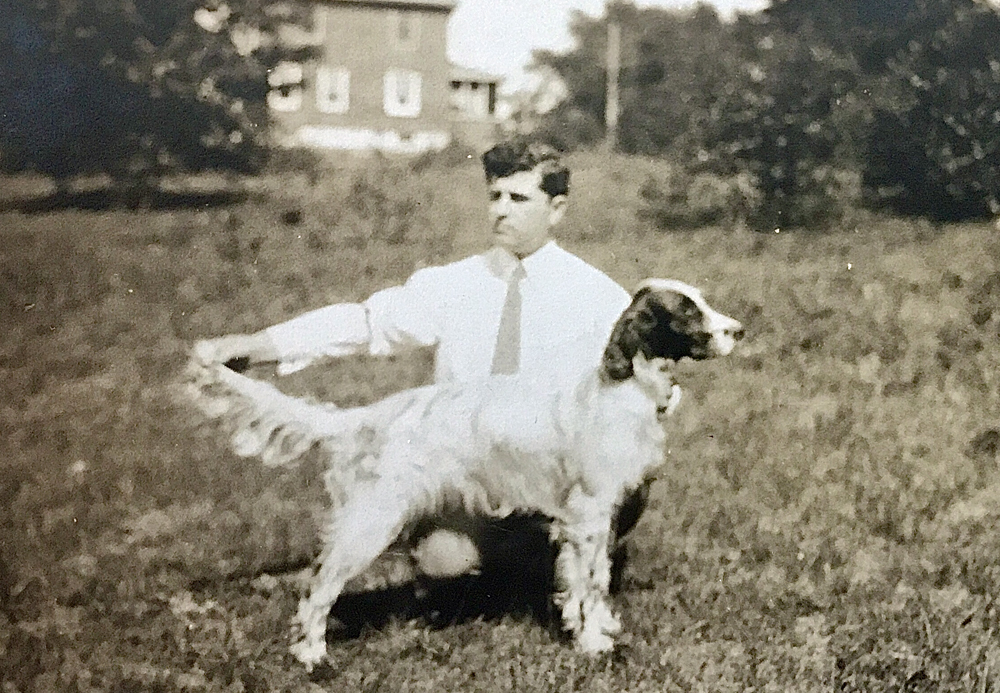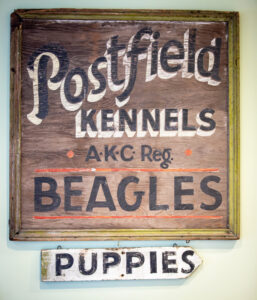True Tales from Canton’s Past: Going to the Dogs
By George T. ComeauIs it nostalgia or aging that brings us back to our childhood as we move through the later years of our life? There are these flashbacks to my youth that fire like an electrical synapse in my brain. I have these gauzy images of the large apple tree in our side yard and my great-grandmother pushing me on a wooden swing. I cannot say that I knew my great-grandparents all that well. I was born when they were in the twilight of their lives. I do recall the house; it was just next door and I vividly remember the kitchen and the gardens that were always immaculate and well-tended.
It was a big and loud Italian family — aren’t they all? The house still stands off of Walpole Street, and it was full of great aunts, uncles, cousins, and of course, my great-grandparents. Brothers and sisters would come and go and as a child I was exposed to the sights of a large, extended immigrant family that was firmly rooted in America. But they also paid homage to Northern Italy through the food and culture that was left behind in the early 1900s. At the head of the table sat Emile Gnotta Verzone, the head of the family in Canton. His wife, Cesira, and his sister Maria were also nearby. Daughter Florence and her husband, Chet, lived upstairs and then more children and grandchildren and even great-grandchildren would be found visiting often. On the table would be polenta, risotto, rabbit and pheasant as well as an abundance of cheeses and fruit. The house smelled of baked apples, saffron threads, tomato sauce and meats. In the living room was an old black and white television with the Red Sox tilting at the bases on a warm summer afternoon. I was 5 years old.
I can remember my great-grandfather, Emile, as a tall man that was always dressed impeccably. By the time my memory kicks in he was in his mid-80s and nearing the end of his life. An accomplished member of the staff at the Copley Plaza in Boston — from the day it opened in 1912 — Emile and his brothers all had a hand in making that grand hotel a success. Emile’s brother Richard was maître d’hôtel, and his other brother Joseph was the chef. The three brothers had come from Italy to work in some of the greatest hotels in New York and Palm Beach.
By the time Emile was 87, I was 7 years old. We grew up on Walpole Street, and the house I was raised in abutted my great-grandparents’ house, which featured a large tract of land, a barn, several kennels and outbuildings. As a child and into my adolescence the barn and kennels held great fascination and were the backdrop to many trespasses and discoveries. Inside the house, in the basement were more kennels and dog runs. Starting in the late 1920s, my great-grandfather had a passion for hunting dogs. Principally he raised English setters and later, beagles.
In my kitchen today hangs a large wooden hand-painted sign that dates to the 1930s. It is a most cherished part of our family history. Emblazoned across the sign in a jaunty script are the words “Postfield Kennels.” The sign was rescued, perhaps purloined, from a burn pile in the barn next to my house and merely survives because it represents a significant story that was an important aspect of the immigrant story in Canton. It’s an heirloom that was liberated from certain destruction. There are dozens of Italian families in Canton that have similar treasures that were rooted in Italy and adapted to life here in the United States.
My family had immigrated to New York in the early 1900s and moved to Boston in 1912. Nono wanted to leave a small apartment on Columbus Avenue and sought out a country house away from the city. In 1923 the family moved to Canton, and within a few short years they began breeding show and hunting dogs.
Postfield Kennels was likely begun in 1930 as a diversion and hobby for my Nono. The kennels were always clean and dozens of puppies would run in these large, enclosed pens, complemented with trap doors into the barn and kennels. I can recall inside the house there was a large, ornate glass case filled with silver cups, bowls and stacks of ribbons that denoted the champions sired on that property. The early breeding was with English setters and his dogs were beautiful. English setters are elegant and solid dogs of beauty and charm. There were three setters that performed exceptionally well: Rex, Tosca and Amerigo.
I grew up hearing stories of these dogs, as if they were childhood cousins of mine. Rex and Amerigo had folklore status for their beauty and grace as show dogs. The dogs were sold to hunters and sportsmen and the kennel had a sterling reputation. One summer day in the early 1950s, Ted Williams drove down the dirt road to Postfield Kennels. Getting out of his car, he called for Emile. Williams was an avid sportsman and had arrived to pick up a hunting dog to add to his pack. Calling out, “Hello, anyone home?” he was answered with a loud, “Go away, go away!” As it turns out, Emile had a crow that could talk and nearly sent Teddy Ballgame packing. Moments later, Emile greeted Williams and the transaction was completed. A baseball was left as a memento, which was given to a cousin many years ago.
The dogs that I remember from my childhood were the beagles. These were the dogs that became quite famous in AKC show circles. The line was rooted in champion breeding. In 1930, the first champ was named Queen, followed in subsequent years through the 1960s by Postfield Star, Zephyr, Postfield Shady, Postfield Plato, Mullin’s Martin, Brownie and another beagle named Postfield Tosca. In 1934, Gino Verzone, my great uncle, won a ribbon at the Brockton Dog Show for showing Rex, the English setter. Later, my great aunt Florence began handling and showing the dogs for her father. Many of the dogs were registered and can be found in the AKC studbooks of the day. The whole family would get into the car and travel to Berkeley and spend the day at the dog shows.
At least two dogs (an English setter and an American beagle) had been named for a Puccini opera, which was so apt for my family. The sounds of Rigoletto, La Traviata, and of course Tosca were always floating through the air when my great-grandparents were alive, and they drew from these sources heavily in the naming of the dogs. Perhaps one of the last dogs bred by Nono was that little beagle named Velvet. And my last memory of my Nono was being sent down the street to a small granite rock outcropping on which he would sit as he wandered away from home. My grandmother would send me to take him by the hand and guide her father back to his house. I was perhaps 6 or 7 years old. Nono had Alzheimer’s or some touch of dementia and he knew things would be okay when the “little boy” came to take him home.
At age 7 I can recall my first wake, funeral and house reception — it was when Nono died. I sat in short pants, knee socks, and saddle shoes in the back porch of the house next door. People came and went; sandwiches and platters of cold cuts were consumed by grieving relatives. As I kicked my shoes against the black wicker furniture, there was the case of ribbons and awards and photos of all the dogs that had been bred at Postfield Kennels. The memory has been with me for almost 50 years. Today, I call my television production company Postfield Productions; my wife and I have always nicknamed our house Postfield; and the sign that hangs in the kitchen is a reminder of heritage and culture in a family that has been in Canton for close to 100 years.
Short URL: https://www.thecantoncitizen.com/?p=71237












